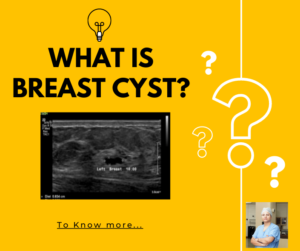Breast cyst are non-cancerous (benign) fluid-filled sacs that are developed inside the breasts. These cysts occur when the fluid is filled in the empty milk gland. Some cysts are small, while some are large enough to cause severe pain. The shape of the breast cysts is like water-filled balloons or grapes. A patient can have one or more than one cysts. The group of these breast cysts can form in one breast breadth of both. Patients feel them went they become painful before the menstrual cycle.
Breast cysts are found in women of any age. But they are more common in women having premenopause and postmenopause (taking hormone therapy). The cysts are commonly found in women aged between 35 to 50 years. Some patients think that these cysts are cancerous lumps that can cause cancer. About one-fourth of the breast masses turn out to be cysts. Most breast cysts do not require any treatment unless the cysts become large, uncomfortable and painful.
Some different types of breast cysts are:
- Simple cysts of the breast –These are non-cancerous entirely fluid-filled cysts.
- Complicated cysts – These types of cysts contain solid substances in the fluid. They are treated through a needle biopsy.
- Complex cysts – These cysts could be cancerous as they have some solid tissues. The complex cysts are also treated with a core needle biopsy or trucut biopsy.
Breast Cyst Causes
Healthcare experts don’t know the exact causes of these cysts. They say that cyst formation takes place due to changes in hormones during menstruation. These cysts are normally formed after menopause when estrogen levels get reduced with sudden hormonal fluctuation.
Breast Cyst Symptoms
Breast cysts can be found in one or both breasts. The symptoms and signs which indicate the presence of these cystic lumps are:
- A patient with may feel breast lumps that are-
- Oval or round shaped
- Hard or soft
- Painful
- Easily movable
- Breast pain
- Increase in the size of breast lump before menstruation
- Nipple discharge can be yellow, dark brown, straw-colored or clear.
- Decrease in the size of breast lump after menstruation.
Associated Problems of cysts of the breast:
Cystic breast lumps do not increase the chances of breast cancer. But these cysts may cause trouble to find breast lumps and other changes. During menstruation, the patient’s breast may feel painful and lumpy. Also, there are some cysts ( cysts with intraductal lesion) that are cancerous and need to be treated in the early stage. If left untreated, these cysts can cause various problems including infection –the cyst fills with pus and bacteria and becomes an abscess. If the abscess gets bursts, it increases the risk of septicemia (blood poisoning).
Breast Cyst Risks
Many women are prone to having lumpy breasts and breast cysts. There are no such risk factors that increase the chances of breast cysts. But in general, breast cysts seem to be genetic that tend to run in families. If women in someone’s family have tender breasts or cysts, then there are chances that the person also has benign breast disease.
Why to consult with Dr Shilpy Dolas?
Dr Shilpy Dolas is one of the best consultant lady breast oncosurgeons. She has years of experience in performing breast reconstruction, cosmetic breast surgeries and breast cancer surgeries. Dr Dolas is working as a breast oncoplastic surgeon and consultant at Heart and breast Care Clinic , Jupiter Hospital, Ruby Hall Clinic , Pune. Patients having breast cysts can take appointment with Dr Shilpy Dolas. She will help them by treating this benign condition with ultra minimally invasive techniques. She provides patients with the best health outcomes. Her expertise can help people live healthy lives.
Clinic Centres
Heart and breast care clinic, plot no. 78/A next to Pune polymer house, near magar stadium, Pimpri Colony, Pune.
FAQs
Q1. Which diagnostic tests do I need to go through to check these cysts of the breast?
Ans. Doctors perform routine mammograms to check these cysts. The patients have to undergo a clinical exam for the screening. Besides mammograms, doctors also perform ultrasound tests to see the breast lump.
Q2. What should I do if I feel a breast lump?
Ans. If a patient feels any changes or breast lump, then she should try to remain calm. She is advised to contact her healthcare advisors and share every information.

